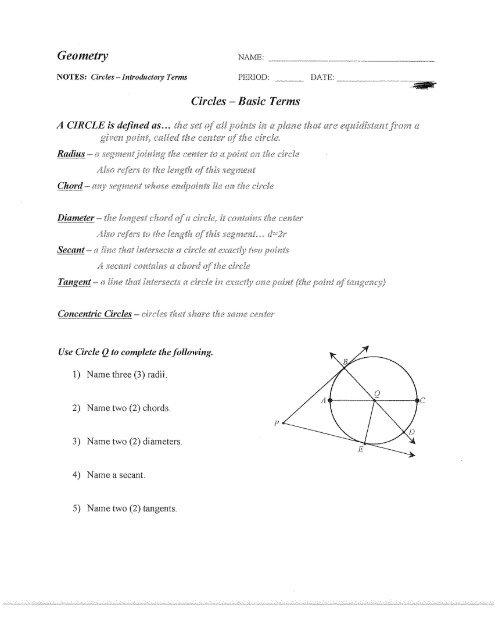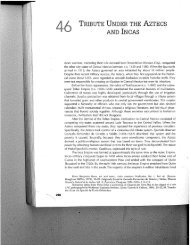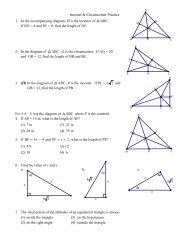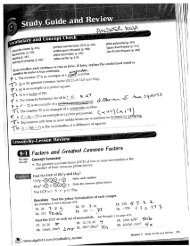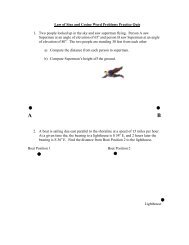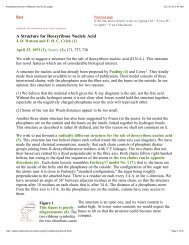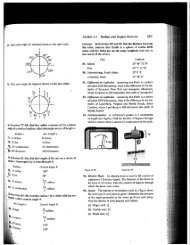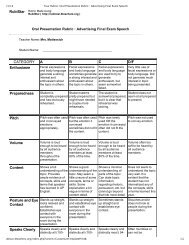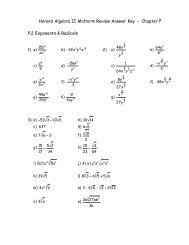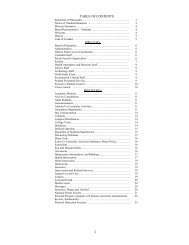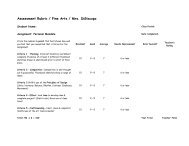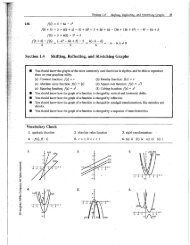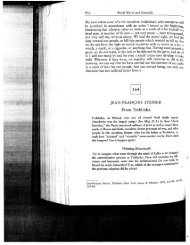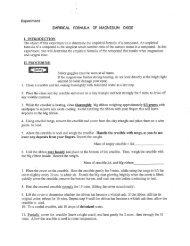Create successful ePaper yourself
Turn your PDF publications into a flip-book with our unique Google optimized e-Paper software.
NAME: ..........................................................................NOTES: <strong>Circles</strong> - Introductory <strong>Terms</strong>PERIOD:<strong>Circles</strong> - <strong>Basic</strong> <strong>Terms</strong>DATE:Use Circle Q to comldete the.fi)llowing:I) Name three (3) radii.2) Name two (2) chords.3) Name two (2) diameters.E4) Name a secant.5) Name two (2) tangents.
G~o~leIFy NAME: ...........................................................NOTES: <strong>Circles</strong> -Arcs & CentralAngles PERIOD: DATE:A circle has a total of 360°...Arcs & Central Angles of <strong>Circles</strong>To understand angle relationships related to circles, the_[bllowing terms are required:~e_.~ffr~AnN]e An angle with its vertex at the center of the circle.ArcAn unbroken part of a circle...any two points on a circle are the endpoints of thearc between them.Like an angle, arc’s have a corresponding degree measure.An arc measuring less than 180°.Minor arcs are named usm~ the arc s e adpomts w~th an arched hat ... ex: ABThe measure of a minor arc is equal to the measure of its central angle. (mAB)An arc measuring more than 180°, but less than 360°.Major arcs are named for the endpoints and a point between them.., ex: ACBThe measure of a major arc is equal to 360° minus the measure of its minor arc.An arc whose endpoints are on a diameter of the circle.A semicircle also uses three letter notation.A semicircle measures 180°.ddjacentArcs Two arcs in the same circle with exactly one point in common (an endpoint).Intercepted Are The arc formed by intersecting an angle with a circle (the arc "cut off" by an angle)Use Circle Q to complete the folhm~ing.1) Name two (2) central angles.2) Name four (4) minor arcs.3) Name four (4) major arcs.4) Name two (2) semicircles.5) Name two (2) minor arcs adjacent to AB.6) Name one (1) major arc adjacent to AB. (Why isAl)l~ NO’r an answer?)7) Name the arc intercepted by/_DQC.8) Ifm/_AQD = 60°, then mAD =9) IfmDBC = 220°, then mDC =and mABD =and mLDQC =
GeometryNAMe:WORKSHEET: Circle Theorems - Chords PERIOD: DATE:The diameters of a given circle all intersect at the center.Therefore, the center of a circle can be found by constructing two diameters.TheoremIn a circle, ~f a diameter is perpendicuhtr to a chord, then it bisects thechord and its arc.A chord that is the perpemlicular bisector of another chord is a diameter.Draw a chord of this circle by first locatingtwo points on the circle (not a diameter).Draw the perpendicular bisector of this chordby first locating the midpoint of the chord.This bisector is a diameter.Repeat this process for another chord.Where do the perpendicular bi sectors intersect?Theorem In a circle or in congruent circles, ~vo chords are congruent ~f and onlythey are equidistant from the center.(The distance to a chord is &~fined as the petwendieular distance,)Solve for x. G In a circle, all radii are congruent!Can you find the radius of circle Q?Theorem In a circle or congruent circles, two minor arcs are congruent O" and only~[’their eorrespomling chords are congruent.~Draw three adjacent congruent arcs by:Draw and label chord AB 3cm long.Draw and label chord BC 3cm longDraw and label chord CD 3cm long.What can we conclude about arcs At3, BC, and C
GeometryWORKSHEET: Circle Theorems PERIOD: DATE:Inscribed Angl~sln~ ’(ibgdA~g~ - an angle whose vertex is on the circle and whose sides are chords ofthe circle.Theorem If an angle is inscribed in a circle, then the measure of the angle equa[sthe measure of the intercepted arc.Write an equation relating a and b in thediagram.Theorem If two inscribed angles intercept the same arc then the angles areDraw two inscribed angles on this circlethat demonstrate this theorem.Theorem If an inscribed angle qf a circle intercepts a semicircle, then the angle is aCreate a diagram to demonstrate this theorem / x,~Th eo remlf’a quadrilateral is inscribed in circle, then its opposite angles areCreate a diagram to demonstrate this theorem / ~
Find all lettered measures andjustiJ) holy you know.120 °
NAM£For use wiih pages 595-682The diameter of a circle is given. Find the radius,1. d= 6in. 2. d = 24cm 3. d= 15ft4. d = 9 in.The radius of a circle is given, Find the diameter,5. r= llcm 6. r= 8ft 7. r= lOin.8. r = 4.6 cmMatch the notation with the term that best describes it.9, D A. Center10. ~ B. Chord11. CD C, Diameter12. AB D. Radius13. C E. Point of tangencyt4. AD E Common external tangent1.5. AB G. Common internal tangent16. ~ H, SecantEUse the diagram at the right.17. What are tile center and radius of18. What are the center and radius of ®B?19, Describe tile intersection of the two circles.20. Describe all the common tangents of the two circles,21. Are the two circles congruent? Explain,Tell whether ~ is tangent to ®C, Explain your reasoning.22. A 23.24. Baseba# Stadium Tbe shape of the outfield fence in abaseball stadium is that of a quarter circle. If the distancefrom home plate to the wail is 330 feet, what is the radiusof the entire circle? What is the diameter of the circle?GeometryChapter 10 Resource BookCopyright © McD0ugal kittell Inc.All rights reserved.


